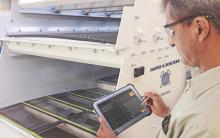
Karen Thompson, president of Haver & Boecker Canada, believes quarry operators should act on a number of time-tested tips for ensuring increased screening uptime.
It’s an industry thousands of years old, with the same materials and same uses today as then. Refining and producing aggregate dates to the Roman Empire, where it was used to establish a network of roads and massive aqueducts. While the purpose of aggregates remains relatively unchanged, manufacturers continue to innovate, developing methods of production the Romans would have only dreamed about.
But, just like the Romans, modern manufacturers continually seek ways to do things better and faster. Producers are striving to say goodbye to downtime and hello to new innovations.
To get the most out of equipment and lessen downtime, consider a few key strategies: a vibration analysis system, a comprehensive service program and proper screen selection and installation.
Good Vibrations
The ideal vibration analysis system is designed specifically for vibrating screens. This offers producers a way to safely monitor their screens’ performance in real time and detect irregularities early — before they lead to diminished performance, decreased efficiency and increased operating costs.
The vibration analysis system should have eight triaxial sensors, which are attached to key places on the equipment. From there the sensors transmit 24 channels of data to a heavy-duty tablet, which then illustrates the machine’s orbit, acceleration and deviations.
Next, find a vibration analysis system that not only offers real-time reporting but also maintains historical reports on the machine’s performance. Storing machine information in the cloud provides indications of repeat concerns that, if addressed, will improve efficiency and decrease expenses.
Also look for a vibration analysis system that provides key reports on the machine’s performance, such as an orbit and tuning report. And, for the greatest reliability, choose a system that sends information via Wi-Fi rather than Bluetooth. Wi-Fi technology has a larger range and higher bandwidth than Bluetooth, which means improved safety, speed and reliability when working near machinery and in isolated areas.
Advanced vibration analysis systems transfer all data wirelessly to a certified engineering team for analysis. Engineers evaluate the machine’s performance, alert the user to any issues, and suggest recommendations for improvement.
If the results require a thorough examination, an engineer will schedule a service call. Otherwise, the customer rests assured that the equipment is healthy and efficient.
Take the Guesswork Out of Installation
Even with the best maintenance plans, issues will occur if screen media isn’t properly selected and installed. Sometimes screening finishes too early, completing before it reaches the end of the screen. By using a heavier screen media with reduced open area on the feed end, you can improve wear life and reduce change-outs while still achieving the right product specifications. Other times it finishes too late, sending wrong-sized material off the discharge end resulting in material contamination, premature screen wear or screen damage.
Other producers might struggle with blinding as clay-heavy materials clog the screen openings, or pegging, where near-sized stones get trapped in screen media openings. Working with a manufacturer proficient in screen media takes the guesswork out of screen installation and ensures extended life of the screen. It’s tough to confidently select a brand and style of screen media, especially with the wide variety from which to choose — from polyurethane and woven wire to a hybrid of the two.
There are square and slotted openings — all of which have different percentages of open area. Top that off with installation options, from tensioned to modular panels. How does a producer begin to choose the options that simplify maintenance and lengthen screen life?
First, understand that each type of screen media serves a different purpose for different applications, and some work best in tandem with other types. Work with a manufacturer or dealer to find the best combination for the operation and to maximise profits by having a screen specialist blend multiple types of screen media on a single deck.
Getting the right style and combination of screen media up front saves time and money by lessening maintenance issues and preventing premature wear.
Lifelong Partnership
Overall, maintaining equipment increases the longevity and efficiency of machines. A good maintenance program prevents downtime because it includes a detailed vibration analysis program, comprehensive service program, and proper screen selection and installation. And, as with any business, profits are the key measure of success.
Partnering with the right manufacturer ensures peak equipment performance and reliability for years to come.
Karen Thompson is the president of








